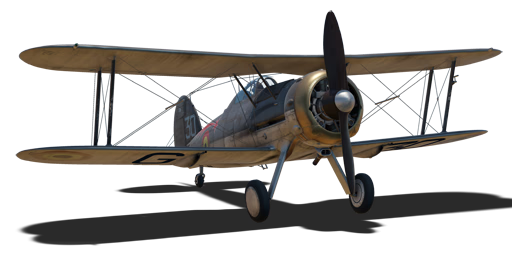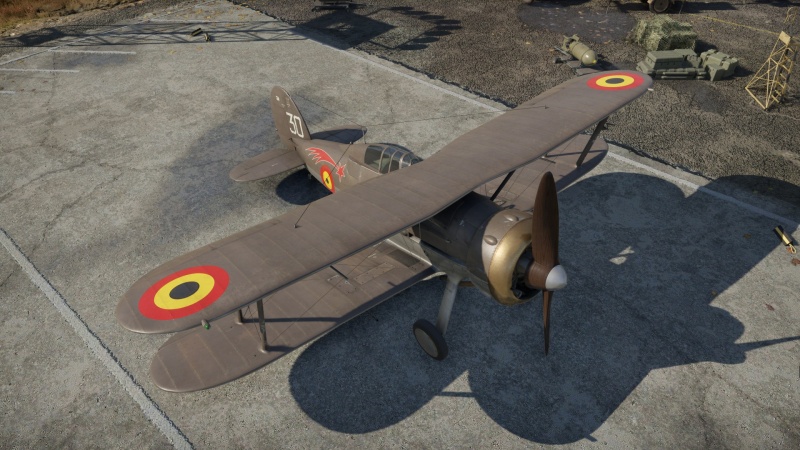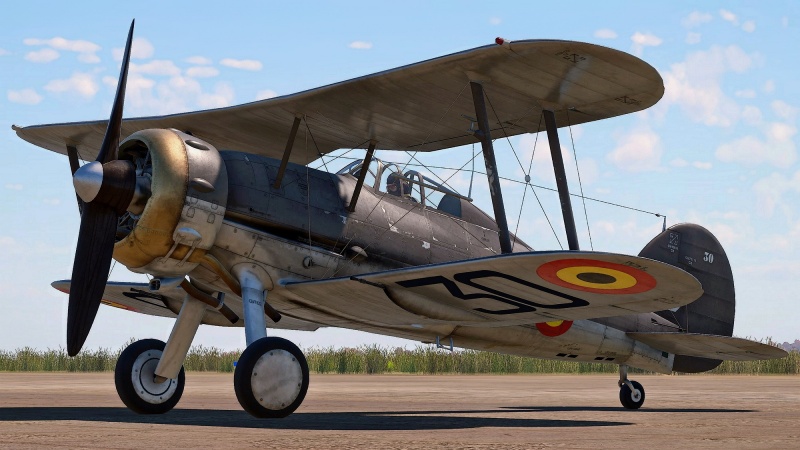Difference between revisions of "Gladiator Mk I (France)"
| Line 1: | Line 1: | ||
{{Specs-Card | {{Specs-Card | ||
|code=gladiator_mk1_belgium | |code=gladiator_mk1_belgium | ||
| − | |images={{Specs-Card-Image|GarageImage_{{PAGENAME}}.jpg}} | + | |images={{Specs-Card-Image|GarageImage_{{PAGENAME}}.jpg|ArtImage_{{PAGENAME}}.jpg}} |
}} | }} | ||
Latest revision as of 10:37, 24 June 2024
Contents
Description
The ▄Gladiator Mk I was part of an aeronautical modernization plan by the Belgian government to keep up with other nations, primarily Germany. This plan involved upgrading the Fairey Firefly IIMs of the 2nd Regiment (I/2Aé). The 1st Squadron 'Thistle' (2/I/2Aé) was upgraded to Hawker Hurricanes, while the 2nd Squadron 'Comet' (1/I/2Aé) received Gloster Gladiators. A total of 22 Gladiators were ordered, with 15 delivered from Gloster and an additional 7 to be assembled by the domestic Belgian aerial industry, SABCA. The Gladiators were primarily used for training in preparation for WWII. During the Phoney War, a Gladiator shot down a He 111. However, six Gladiators were lost due to attrition, and one was kept unarmed as a personal aircraft (G-38) by General Hiernaux. This left 16 Gladiators serviceable by the start of the German Blitzkrieg on May 10, 1940. Most Gladiators were lost during taxiing and take-off at the start of the battle by an air raid of Do 17s of JG 77. The remaining Gladiators faced off against the superior Bf 109s of I./JG 1, suffering heavy losses. The last two surviving Gladiators, both severely damaged, retreated to Beauvechain. On the afternoon of the next day, May 11, 1940, I./JG 1 returned and strafed the airfield with twelve Bf 109s, dealing the final blow to I/2 Aé, which had just lost the last aircraft of its force composed of Hurricanes and Gladiators.
This aircraft's specific camouflage represents Gladiator 'G-30' of the 2nd Squadron 'La Comète' (1/I/2Aé) of the Belgian Air Force. G-30 was acquired in the second batch of September 1937 but crashed in a snowstorm at Rognée (near Namur) on February 11, 1938.
It was introduced in Update "Seek & Destroy". The Belgian Gladiator Mk I is the first aircraft available for players in the BeNeLux subtree. Its playstyle and performance is practically identical to the other aircraft of the Gladiator (Family), so pilots who have flown other aircraft of this type in the British, Chinese and Swedish tech trees will already be familiar with it. For beginners, the Belgian Gladiator Mk I offers a reliable platform which excels in turnfighting.
General info
Flight performance
Being a biplane, the Belgian Gladiator Mk I has excellent manoeuvrability and can make very tight turns in dogfights with the enemy. Monoplane fighters may find it difficult to get a shot on the Gladiator if they are manoeuvring at slow airspeeds. Gladiator Mk I pilots should be aware, however, that some enemy biplanes can be more manoeuvrable than them, such as the Ki-10-I which is capable of performing even tighter turns.
Another concern for Gladiator pilots is that some enemies that may be encountered in battle such as the Bf 109 C-1 and G.50 serie 2 can easily run away from or chase down the Gladiator due to their higher speed.
| Characteristics | Max speed (km/h at 4,420 m) |
Max altitude (metres) |
Turn time (seconds) |
Rate of climb (metres/second) |
Take-off run (metres) | |||
|---|---|---|---|---|---|---|---|---|
| AB | RB | AB | RB | AB | RB | |||
| Stock | 400 | 387 | 10211 | 16.7 | 17.4 | 13.4 | 13.4 | 232 |
| Upgraded | ___ | ___ | __._ | __._ | __._ | __._ | ||
Details
| Features | ||||
|---|---|---|---|---|
| Combat flaps | Take-off flaps | Landing flaps | Air brakes | Arrestor gear |
| X | ✓ | ✓ | X | X |
| Limits | ||||||
|---|---|---|---|---|---|---|
| Wings (km/h) | Gear (km/h) | Flaps (km/h) | Max Static G | |||
| Combat | Take-off | Landing | + | - | ||
| 0 | 560 | ___ | ___ | ___ | ~__ | ~__ |
| Optimal velocities (km/h) | |||
|---|---|---|---|
| Ailerons | Rudder | Elevators | Radiator |
| < ___ | < ___ | < ___ | > ___ |
Survivability and armour
The Gladiator Mk I has no armour. Even light calibre weapons can do damage to the important components of the Gladiator, such as the engine and controls. The cockpit is also unarmoured, which can lead to the pilot being knocked out even before the aircraft takes significant damage.
Modifications and economy
The Belgian Gladiator Mk I is a relatively simple aircraft, so pilots may choose what modifications they want to research first according to their preferences. One possible order of research is as follows:
- Weaponry: These modifications will allow for the selection of different ammunition belts and can increase the lethality of the Gladiator's armament.
- Flight Performance: These modifications will help to increase the aircraft's speed and manoeuvrability, allowing it to catch up to and turnfight enemies more effectively.
- Survivability: These modifications will increase the durability of the aircraft, strengthening parts against enemy fire.
Armaments
Offensive armament
The Gladiator Mk I (France) is armed with:
- 2 x 7.7 mm Browning machine guns, nose-mounted (600 rpg = 1,200 total)
- 2 x 7.7 mm Browning machine guns, wing-mounted (400 rpg = 800 total)
The armament of the Belgian Gladiator Mk I is good for the tier, consisting of four reliable Browning (7.7 mm) machine guns. With two in the nose and two placed fairly close on the wings, these guns will be relatively easy to aim as gun convergence is less of a factor. These guns have decent fire rate and damage against light aircraft. However, heavier and tougher aircraft, especially those with armour, may need more than a few bursts to be able to take down.
Usage in battles
The Belgian Gladiator Mk I is a decent starting aircraft for new players. A stable but manoeuvrable platform, players will be able to turn fight with enemies quite easily. If encountering enemy aircraft with a significant speed advantage over the Gladiator Mk I, it is recommended to attempt to engage them in a turnfight so that they will be forced to manoeuvre, reducing their airspeed and allowing the Gladiator to get close.
Due to the lack of armour, it is recommended to avoid taking damage, especially getting attacked from behind as the pilot is unprotected from enemy fire. The Gladiator Mk I's armament is formidable for its tier. In a head-on attack, however, pilots should be wary as the aircraft's large radial engine is prone to taking damage. It is recommended to engage in a frontal attack early and disengage before the enemy begins firing, manoeuvring out of the way to initiate a turn fight.
Enemies worth noting:
- Bf 109, He 112, He 100 D-1 - As confirmed in history, these German fighters have a tremendous speed and acceleration advantage against the Gladiator Mk I, which can cause trouble for the Gladiator if they are positioned at a higher altitude. From up high, these aircraft can perform Boom & Zoom attacks, diving on the Gladiator and then escaping back up to altitude.
- Ki-10, I-15 - These biplanes are even more manoeuvrable than the Gladiator Mk I and can quickly outturn this aircraft at low speeds.
- BV 138 C-1, H6K4 and other Bombers - Bombers will often be flying at high altitudes, just out of reach of the Gladiator Mk I. They will often carry defensive gunners which can do significant damage to the aircraft and engine, especially if they are using heavy autocannons. In addition, bombers' airframes will often be tougher than fighter aircraft and feature multiple engines, meaning they can be a challenge to shoot down without using a lot of ammo.
Pros and cons
Pros:
- Armament is equal to or better than other fighters it typically faces
- Good manoeuvrability in a turn, fantastic turnfighter
- Tracer belts, like all other planes fitted with Browning machine guns, can be deadly
- Has flaps, unlike most other biplane fighters
- Sufficient ammunition prevents frequent reloads or landing to rearm
Cons:
- Performance deficiencies can make it an easy target for experienced pilots or more difficult adversaries
- Not the best climber
- Bleeds speed in turns, especially when using flaps
- In Simulator mode, upper wing blocks a significant amount of the forward view
- Extremely weak roll, combined with the lack of rudder authority leads to extreme difficulty aiming
History
The Gladiator Mk I was a British single engine biplane fighter designed by Gloster, entering service with the Royal Air Force in 1936.
The type would be exported to multiple countries including Belgium, who ordered twenty-two aircraft. The first batch would be built by Gloster, while the second batch would be produced by SABCA locally in Belgium. The Gladiators would be put into service with the 1st Escadrille de Chasse 'La Comète' in 1937.
Several Gladiators of the Belgian Army Air Forces were damaged or destroyed in accidents before WWII, including Gladiator 'G-30' which crashed during a snowstorm in Namur, Belgium in 1938.
During the Invasion of Belgium in 1940, the Belgian Gladiators engaged in combat for the first time following a surprise bombing raid by the German Luftwaffe on Schaffen Air Base. Unfortunately, as experienced by other operators of the type, it was found that the Gladiator was hopelessly outdated against the new German fighter types such as the Bf 109. Belgium surrendered just eighteen days after the invasion and the entire Belgian Gladiator fleet had been effectively destroyed.
Media
Excellent additions to the article would be video guides, screenshots from the game, and photos.
See also
- Related Development
- Gladiator (Family)
- Gladiator Mk I (China) (other export Gladiator Mk Is)
- Planes of comparable role, configuration and era
External links
| Gloster Aircraft Company, Limited | |
|---|---|
| Fighters | Gladiator Mk II · Sea Gladiator Mk I · Gladiator Mk IIF · Gladiator Mk IIS · Tuck's Gladiator Mk II |
| Jet Fighters | Meteor F Mk 3 · Sea Meteor F Mk 3 · Meteor F Mk 4 G.41F · Meteor F Mk 4 G.41G · Meteor F Mk 8 G.41K · Meteor F Mk.8 Reaper |
| Javelin F.(A.W.) Mk.9 | |
| Export | J8A · Iacobi's J8A · ␗Gladiator Mk I · ▄Gladiator Mk I |
| ▄Meteor F Mk.8 · Meteor F.8 · Meteor NF.13 | |
| See Also | Fokker |
| France fighters | |
|---|---|
| Dewoitine | D.371 · D.371 H.S.9 · D.373 · D.500 · D.501 · Pallier's D.510 · D.520 |
| Morane-Saulnier | M.S.405C1 · M.S.406C1 · M.S.410 |
| Arsenal | V.G.33C-1 |
| Bloch | M.B.152C1 · M.B.157 |
| Caudron | C.R.714 |
| Sud-Ouest | S.O.8000 Narval |
| American | H-75A-1 · H-75A-4 · ▄P-39Q-25 · ▄P-40F-5 Lafayette · ▄P-47D-22-RE · ▄P-63C-5 · F-6C-10-NA |
| ▄F6F-5 · ▄F6F-5N · F4U-7 · ▄F8F-1B | |
| Other countries | ▄Seafire LF Mk.III · ▄Yak-3 · Challe's ▄Yak-9T · NC.900 |
| Belgium | ▄Gladiator Mk I · ▄Spitfire FR Mk XIVe |
| Netherlands | ◘Sea Fury FB 51 |






